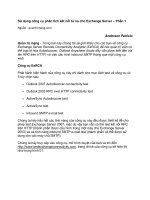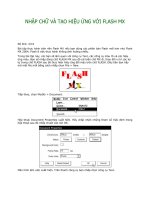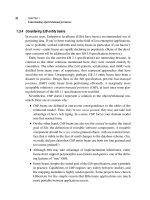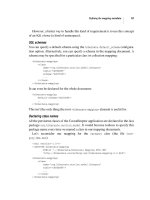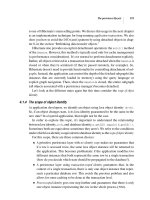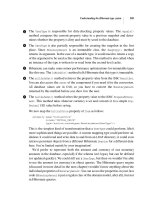manning Hibernate in Action phần 1 docx
Bạn đang xem bản rút gọn của tài liệu. Xem và tải ngay bản đầy đủ của tài liệu tại đây (2.74 MB, 42 trang )
Hibernate in Action
Hibernate in Action
CHRISTIAN BAUER
GAVIN KING
MANNING
Greenwich
(74° w. long.)
Licensed to Jose Carlos Romero Figueroa <>
For online information and ordering of this and other Manning books, please visit
www.manning.com. The publisher offers discounts on this book when ordered in
quantity. For more information, please contact:
Special Sales Department
Manning Publications Co.
209 Bruce Park Avenue Fax: (203) 661-9018
Greenwich, CT 06830 email:
©2005 by Manning Publications Co. All rights reserved.
No part of this publication may be reproduced, stored in a retrieval system, or transmitted,
in any form or by means electronic, mechanical, photocopying, or otherwise, without
prior written permission of the publisher.
Many of the designations used by manufacturers and sellers to distinguish their products
are claimed as trademarks. Where those designations appear in the book, and Manning
Publications was aware of a trademark claim, the designations have been printed in initial
caps or all caps.
Recognizing the importance of preserving what has been written, it is Manning’s policy to have
the books they publish printed on acid-free paper, and we exert our best efforts to that end.
.
Manning Publications Co. Copyeditor: Tiffany Taylor
209 Bruce Park Avenue Typesetter: Dottie Marsico
Greenwich, CT 06830 Cover designer: Leslie Haimes
ISBN 1932394-15-X
Printed in the United States of America
12 34567 8910– VHG–07 06 05 04
Licensed to Jose Carlos Romero Figueroa <>
contents
foreword xi
about Hibernate3 and EJB 3 xx
author online xxi
about the title and cover xxii
preface xiii
acknowledgments xv
about this book xvi
1
Understanding object/relational persistence 1
1.1 What is persistence? 3
Relational databases 3
■
Understanding SQL 4
■
Using SQL
in Java 5
■
Persistence in object-oriented applications 5
1.2 The paradigm mismatch 7
The problem of granularity 9
■
The problem of subtypes 10
The problem of identity 11
■
Problems relating to associations 13
The problem of object graph navigation 14
■
The cost of the
mismatch 15
1.3 Persistence layers and alternatives 16
Layered architecture 17
■
Hand-coding a persistence layer with
SQL/JDBC 18
■
Using serialization 19
■
Considering EJB
entity beans 20
■
Object-oriented database systems 21
Other options 22
1.4 Object/relational mapping 22
What is ORM? 23
■
Generic ORM problems 25
Why ORM? 26
1.5 Summary 29
v
Licensed to Jose Carlos Romero Figueroa <>
vi CONTENTS
2
Introducing and integrating Hibernate 30
2.1 “Hello World” with Hibernate 31
2.2 Understanding the architecture 36
The core interfaces 38
■
Callback interfaces 40
Types 40
■
Extension interfaces 41
2.3 Basic configuration 41
Creating a SessionFactory 42
■
Configuration in
non-managed environments 45
■
Configuration in
managed environments 48
2.4 Advanced configuration settings 51
Using XML-based configuration 51
SessionFactory 53
■
Logging 54
Extensions (JMX) 55
2.5 Summary 58
3
Mapping persistent classes 59
■
JNDI-bound
■
Java Management
3.1 The CaveatEmptor application 60
Analyzing the business domain 61
The CaveatEmptor domain model 61
3.2 Implementing the domain model 64
Addressing leakage of concerns 64
■
Transparent and
automated persistence 65
■
Writing POJOs 67
Implementing POJO associations 69
■
Adding logic to
accessor methods 73
3.3 Defining the mapping metadata 75
Metadata in XML 75
■
Basic property and class
mappings 78
■
Attribute-oriented programming 84
Manipulating metadata at runtime 86
3.4 Understanding object identity 87
Identity versus equality 87
■
Database identity with
Hibernate 88
■
Choosing primary keys 90
3.5 Fine-grained object models 92
Entity and value types 93
■
Using components 93
3.6 Mapping class inheritance 97
Table per concrete class 97
■
Table per class hierarchy 99
Table per subclass 101
■
Choosing a strategy 104
Licensed to Jose Carlos Romero Figueroa <>
vii CONTENTS
3.7 Introducing associations 105
Managed associations? 106
■
Multiplicity 106
The simplest possible association 107
■
Making the association
bidirectional 108
■
A parent/child relationship 111
3.8 Summary 112
4
Working with persistent objects 114
4.1 The persistence lifecycle 115
Transient objects 116
■
Persistent objects 117
■
Detached
objects 118
■
The scope of object identity 119
■
Outside the
identity scope 121
■
Implementing equals() and hashCode() 122
4.2 The persistence manager 126
Making an object persistent 126
■
Updating the persistent state
of a detached instance 127
■
Retrieving a persistent object 129
Updating a persistent object 129
■
Making a persistent object
transient 129
■
Making a detached object transient 130
4.3 Using transitive persistence in Hibernate 131
Persistence by reachability 131
■
Cascading persistence with
Hibernate 133
■
Managing auction categories 134
Distinguishing between transient and detached instances 138
4.4 Retrieving objects 139
Retrieving objects by identifier 140
■
Introducing HQL 141
Query by criteria 142
■
Query by example 143
■
Fetching
strategies 143
■
Selecting a fetching strategy in mappings 146
Tuning object retrieval 151
4.5 Summary 152
5
Transactions, concurrency, and caching 154
5.1 Transactions, concurrency, and caching 154
5.2 Understanding database transactions 156
JDBC and JTA transactions 157
■
The Hibernate Transaction
API 158
■
Flushing the Session 160
■
Understanding isolation
levels 161
■
Choosing an isolation level 163
■
Setting an
isolation level 165
■
Using pessimistic locking 165
5.3 Working with application transactions 168
Using managed versioning 169
■
Granularity of a
Session 172
■
Other ways to implement optimistic locking 174
Licensed to Jose Carlos Romero Figueroa <>
viii CONTENTS
5.4 Caching theory and practice 175
Caching strategies and scopes 176
■
The Hibernate cache
architecture 179
■
Caching in practice 185
5.5 Summary 194
6
Advanced mapping concepts 195
6.1 Understanding the Hibernate type system 196
Built-in mapping types 198
■
Using mapping types 200
6.2 Mapping collections of value types 211
Sets, bags, lists, and maps 211
6.3 Mapping entity associations 220
One-to-one associations 220
■
Many-to-many associations 225
6.4 Mapping polymorphic associations 234
Polymorphic many-to-one associations 234
■
Polymorphic
collections 236
■
Polymorphic associations and table-per-
concrete-class 237
6.5 Summary 239
7
Retrieving objects efficiently 241
7.1 Executing queries 243
The query interfaces 243
■
Binding parameters 245
Using named queries 249
7.2 Basic queries for objects 250
The simplest query 250
■
Using aliases 251
■
Polymorphic
queries 251
■
Restriction 252
■
Comparison operators 253
String matching 255
■
Logical operators 256
■
Ordering query
results
257
7.3 Joining associations 258
Hibernate join options 259
■
Fetching associations 260
265
268
Using aliases with joins 262
■
Using implicit joins
Theta-style joins 267
■
Comparing identifiers
7.4 Writing report queries 269
Projection 270
■
Using aggregation 272
■
Grouping 273
Restricting groups with having 274
■
Improving performance
with report queries
275
Licensed to Jose Carlos Romero Figueroa <>
ix CONTENTS
7.5 Advanced query techniques 276
Dynamic queries 276
■
Collection filters 279
Subqueries 281
■
Native SQL queries 283
7.6 Optimizing object retrieval 286
Solving the n+1 selects problem 286
■
Using iterate()
queries 289
■
Caching queries 290
7.7 Summary 292
8
Writing Hibernate applications 294
8.1 Designing layered applications 295
Using Hibernate in a servlet engine 296
Using Hibernate in an EJB container 311
8.2 Implementing application transactions 320
Approving a new auction 321
■
Doing it the hard way 322
Using detached persistent objects 324
■
Using a long session 325
Choosing an approach to application transactions 329
8.3 Handling special kinds of data 330
Legacy schemas and composite keys 330
■
Audit logging 340
8.4 Summary 347
9
Using the toolset 348
9.1 Development processes 349
Top down 350
■
Bottom up 350
■
Middle out (metadata
oriented) 350
■
Meet in the middle 350
Roundtripping 351
9.2 Automatic schema generation 351
Preparing the mapping metadata 352
■
Creating the
schema 355
■
Updating the schema 357
9.3 Generating POJO code 358
Adding meta-attributes 358
■
Generating finders 360
Configuring hbm2java 362
■
Running hbm2java 363
9.4 Existing schemas and Middlegen 364
Starting Middlegen 364
■
Restricting tables and
relationships 366
■
Customizing the metadata generation 368
Generating hbm2java and XDoclet metadata 370
Licensed to Jose Carlos Romero Figueroa <>
x CONTENTS
9.5 XDoclet 372
Setting value type attributes 372
■
Mapping entity
associations 374
■
Running XDoclet 375
9.6 Summary 376
appendix A: SQL fundamentals 378
appendix B: ORM implementation strategies 382
B.1 Properties or fields? 383
B.2 Dirty-checking strategies 384
appendix C: Back in the real world 388
C.1 The strange copy 389
C.2 The more the better 390
C.3 We don’t need primary keys 390
C.4 Time isn’t linear 391
C.5 Dynamically unsafe 391
C.6 To synchronize or not? 392
C.7 Really fat client 393
C.8 Resuming Hibernate 394
references 395
index 397
Licensed to Jose Carlos Romero Figueroa <>
foreword
Relational databases are indisputably at the core of the modern enterprise.
While modern programming languages, including Java
TM
, provide an intuitive,
object-oriented view of application-level business entities, the enterprise data
underlying these entities is heavily relational in nature. Further, the main strength
of the relational model—over earlier navigational models as well as over later
OODB models—is that by design it is intrinsically agnostic to the programmatic
manipulation and application-level view of the data that it serves up.
Many attempts have been made to bridge relational and object-oriented tech-
nologies, or to replace one with the other, but the gap between the two is one of
the hard facts of enterprise computing today. It is this challenge—to provide a
bridge between relational data and Java
TM
objects—that Hibernate takes on
through its object/relational mapping (
ORM) approach. Hibernate meets this
challenge in a very pragmatic, direct, and realistic way.
As Christian Bauer and Gavin King demonstrate in this book, the effective use
of
ORM technology in all but the simplest of enterprise environments requires
understanding and configuring how the mediation between relational data and
objects is performed. This demands that the developer be aware and knowledge-
able both of the application and its data requirements, and of the
SQL query lan-
guage, relational storage structures, and the potential for optimization that
relational technology offers.
Not only does Hibernate provide a full-function solution that meets these
requirements head on, it is also a flexible and configurable architecture. Hiber-
nate’s developers designed it with modularity, pluggability, extensibility, and user
customization in mind. As a result, in the few years since its initial release,
xi
Licensed to Jose Carlos Romero Figueroa <>
xii FOREWORD
Hibernate has rapidly become one of the leading ORM technologies for enter-
prise developers—and deservedly so.
This book provides a comprehensive overview of Hibernate. It covers how to
use its type mapping capabilities and facilities for modeling associations and
inheritance; how to retrieve objects efficiently using the Hibernate query lan-
guage; how to configure Hibernate for use in both managed and unmanaged
environments; and how to use its tools. In addition, throughout the book the
authors provide insight into the underlying issues of
ORM and into the design
choices behind Hibernate. These insights give the reader a deep understanding
of the effective use of
ORM as an enterprise technology.
Hibernate in Action is the definitive guide to using Hibernate and to object/rela-
tional mapping in enterprise computing today.
L
INDA DEMICHIEL
Lead Architect, Enterprise JavaBeans
Sun Microsystems
Licensed to Jose Carlos Romero Figueroa <>
preface
Just because it is possible to push twigs along the ground with one’s nose does
not necessarily mean that that is the best way to collect firewood.
—Anthony Berglas
Today, many software developers work with Enterprise Information Systems (
EIS).
This kind of application creates, manages, and stores structured information and
shares this information between many users in multiple physical locations.
The storage of
EIS data involves massive usage of SQL-based database manage-
ment systems. Every company we’ve met during our careers uses at least one
SQL
database; most are completely dependent on relational database technology at
the core of their business.
In the past five years, broad adoption of the Java programming language has
brought about the ascendancy of the object-oriented paradigm for software devel-
opment. Developers are now sold on the benefits of object orientation. However,
the vast majority of businesses are also tied to long-term investments in expensive
relational database systems. Not only are particular vendor products entrenched,
but existing legacy data must be made available to (and via) the shiny new object-
oriented web applications.
However, the tabular representation of data in a relational system is fundamen-
tally different than the networks of objects used in object-oriented Java applica-
tions. This difference has led to the so-called object/relational paradigm mismatch.
Traditionally, the importance and cost of this mismatch have been underesti-
mated, and tools for solving the mismatch have been insufficient. Meanwhile, Java
developers blame relational technology for the mismatch; data professionals
blame object technology.
xiii
Licensed to Jose Carlos Romero Figueroa <>
xiv PREFACE
Object/relational mapping (ORM) is the name given to automated solutions to the
mismatch problem. For developers weary of tedious data access code, the good
news is that
ORM has come of age. Applications built with ORM middleware can be
expected to be cheaper, more performant, less vendor-specific, and more able to
cope with changes to the internal object or underlying
SQL schema. The astonish-
ing thing is that these benefits are now available to Java developers for free.
Gavin King began developing Hibernate in late 2001 when he found that the
popular persistence solution at the time—
CMP Entity Beans—didn’t scale to non-
trivial applications with complex data models. Hibernate began life as an inde-
pendent, noncommercial open source project.
The Hibernate team (including the authors) has learned
ORM the hard way—
that is, by listening to user requests and implementing what was needed to satisfy
those requests. The result, Hibernate, is a practical solution, emphasizing devel-
oper productivity and technical leadership. Hibernate has been used by tens of
thousands of users and in many thousands of production applications.
When the demands on their time became overwhelming, the Hibernate team
concluded that the future success of the project (and Gavin’s continued sanity)
demanded professional developers dedicated full-time to Hibernate. Hibernate
joined jboss.org in late 2003 and now has a commercial aspect; you can purchase
commercial support and training from JBoss Inc. But commercial training
shouldn’t be the only way to learn about Hibernate.
It’s obvious that many, perhaps even most, Java projects benefit from the use of
an
ORM solution like Hibernate—although this wasn’t obvious a couple of years
ago! As
ORM technology becomes increasingly mainstream, product documenta-
tion such as Hibernate’s free user manual is no longer sufficient. We realized that
the Hibernate community and new Hibernate users needed a full-length book,
not only to learn about developing software with Hibernate, but also to under-
stand and appreciate the object/relational mismatch and the motivations behind
Hibernate’s design.
The book you’re holding was an enormous effort that occupied most of our
spare time for more than a year. It was also the source of many heated disputes
and learning experiences. We hope this book is an excellent guide to Hibernate
(or, “the Hibernate bible,” as one of our reviewers put it) and also the first com-
prehensive documentation of the object/relational mismatch and
ORM in gen-
eral. We hope you find it helpful and enjoy working with Hibernate.
Licensed to Jose Carlos Romero Figueroa <>
acknowledgments
Writing (in fact, creating) a book wouldn’t be possible without help. We’d first
like to thank the Hibernate community for keeping us on our toes; without your
requests for the book, we probably would have given up early on.
A book is only as good as its reviewers, and we had the best. J. B. Rainsberger,
Matt Scarpino, Ara Abrahamian, Mark Eagle, Glen Smith, Patrick Peak, Max
Rydahl Andersen, Peter Eisentraut, Matt Raible, and Michael A. Koziarski. Thanks
for your endless hours of reading our half-finished and raw manuscript. We’d like
to thank Emmanuel Bernard for his technical review and Nick Heudecker for his
help with the first chapters.
Our team at Manning was invaluable. Clay Andres got this project started,
Jackie Carter stayed with us in good and bad times and taught us how to write.
Marjan Bace provided the necessary confidence that kept us going. Tiffany Taylor
and Liz Welch found all the many mistakes we made in grammar and style. Mary
Piergies organized the production of this book. Many thanks for your hard work.
Any others at Manning whom we’ve forgotten: You made it possible.
xv
Licensed to Jose Carlos Romero Figueroa <>
about this book
We introduce the object/relational paradigm mismatch in this book and give you
a high-level overview of current solutions for this time-consuming problem. You’ll
learn how to use Hibernate as a persistence layer with a richly typed domain
object model in a single, continuing example application. This persistence layer
implementation covers all entity association, class inheritance, and special type
mapping strategies.
We teach you how to tune the Hibernate object query and transaction system
for the best performance in highly concurrent multiuser applications. The flexible
Hibernate dual-layer caching system is also an important topic in this book. We dis-
cuss Hibernate integration in different scenarios and also show you typical archi-
tectural problems in two- and three-tiered Java database applications. If you have
to work with an existing
SQL database, you’ll also be interested in Hibernate’s leg-
acy database integration features and the Hibernate development toolset.
Roadmap
Chapter 1 defines object persistence. We discuss why a relational database with a
SQL interface is the system for persistent data in today’s applications, and why
hand-coded Java persistence layers with
JDBC and SQL code are time-consuming
and error-prone. After looking at alternative solutions for this problem, we intro-
duce object/relational mapping and talk about the advantages and downsides of
this approach.
Chapter 2 gives an architectural overview of Hibernate and shows you the
most important application-programming interfaces. We demonstrate Hibernate
xvi
Licensed to Jose Carlos Romero Figueroa <>
xvii ABOUT THIS BOOK
configuration in managed (and non-managed) J2EE and J2SE environments after
looking at a simple “Hello World” application.
Chapter 3 introduces the example application and all kinds of entity and rela-
tionship mappings to a database schema, including uni- and bidirectional associa-
tions, class inheritance, and composition. You’ll learn how to write Hibernate
mapping files and how to design persistent classes.
Chapter 4 teaches you the Hibernate interfaces for read and save operations;
we also show you how transitive persistence (persistence by reachability) works in
Hibernate. This chapter is focused on loading and storing objects in the most effi-
cient way.
Chapter 5 discusses concurrent data access, with database and long-running
application transactions. We introduce the concepts of locking and versioning of
data. We also cover caching in general and the Hibernate caching system, which
are closely related to concurrent data access.
Chapter 6 completes your understanding of Hibernate mapping techniques
with more advanced mapping concepts, such as custom user types, collections of
values, and mappings for one-to-one and many-to-many associations. We briefly
discuss Hibernate’s fully polymorphic behavior as well.
Chapter 7 introduces the Hibernate Query Language (
HQL) and other object-
retrieval methods such as the query by criteria (
QBC) API, which is a typesafe way
to express an object query. We show you how to translate complex search dialogs
in your application to a query by example (
QBE) query. You’ll get the full power of
Hibernate queries by combining these three features; we also show you how to use
direct
SQL calls for the special cases and how to best optimize query performance.
Chapter 8 describes some basic practices of Hibernate application architecture.
This includes handling the
SessionFactory, the popular ThreadLocal Session pat-
tern, and encapsulation of the persistence layer functionality in data access objects
(
DAO) and J2EE commands. We show you how to design long-running application
transactions and how to use the innovative detached object support in Hibernate.
We also talk about audit logging and legacy database schemas.
Chapter 9 introduces several different development scenarios and tools that
may be used in each case. We show you the common technical pitfalls with each
approach and discuss the Hibernate toolset (hbm2ddl, hbm2java) and the inte-
gration with popular open source tools such as XDoclet and Middlegen.
Licensed to Jose Carlos Romero Figueroa <>
xviii ABOUT THIS BOOK
Who should read this book?
Readers of this book should have basic knowledge of object-oriented software
development and should have used this knowledge in practice. To understand the
application examples, you should be familiar with the Java programming lan-
guage and the Unified Modeling Language.
Our primary target audience consists of Java developers who work with SQL-
based database systems. We’ll show you how to substantially increase your produc-
tivity by leveraging
ORM.
If you’re a database developer, the book could be part of your introduction to
object-oriented software development.
If you’re a database administrator, you’ll be interested in how
ORM affects per-
formance and how you can tune the performance of the
SQL database manage-
ment system and persistence layer to achieve performance targets. Since data
access is the bottleneck in most Java applications, this book pays close attention to
performance issues. Many
DBAs are understandably nervous about entrusting per-
formance to tool-generated
SQL code; we seek to allay those fears and also to
highlight cases where applications should not use tool-managed data access. You
may be relieved to discover that we don’t claim that
ORM is the best solution to
every problem.
Code conventions and downloads
This book provides copious examples, which include all the Hibernate applica-
tion artifacts: Java code, Hibernate configuration files, and XML mapping meta-
data files. Source code in listings or in text is in a fixed-width font
like this to
separate it from ordinary text. Additionally, Java method names, component
parameters, object properties, and
XML elements and attributes in text are also
presented using fixed-width font.
Java,
HTML, and XML can all be verbose. In many cases, the original source code
(available online) has been reformatted; we’ve added line breaks and reworked
indentation to accommodate the available page space in the book. In rare cases,
even this was not enough, and listings include line-continuation markers. Addi-
tionally, comments in the source code have been removed from the listings.
Licensed to Jose Carlos Romero Figueroa <>
xixABOUT THIS BOOK
Code annotations accompany many of the source code listings, highlighting
important concepts. In some cases, numbered bullets link to explanations that fol-
low the listing.
Hibernate is an open source project released under the Lesser GNU Public
License. Directions for downloading Hibernate, in source or binary form, are
available from the Hibernate web site: www.hibernate.org/.
The source code for all CaveatEmptor examples in this book is available from
The CaveatEmptor example application
code is available on this web site in different flavors: for example, for servlet and for
EJB deployment, with or without a presentation layer. However, only the standal-
one persistence layer source package is the recommended companion to this book.
About the authors
Christian Bauer is a member of the Hibernate developer team and is also respon-
sible for the Hibernate web site and documentation. Christian is interested in rela-
tional database systems and sound data management in Java applications. He
works as a developer and consultant for JBoss Inc. and lives in Frankfurt, Germany.
Gavin King is the founder of the Hibernate project and lead developer. He is
an enthusiastic proponent of agile development and open source software. Gavin
is helping integrate
ORM technology into the J2EE standard as a member of the
EJB 3 Expert Group. He is a developer and consultant for JBoss Inc., based in Mel-
bourne, Australia.
Licensed to Jose Carlos Romero Figueroa <>
about Hibernate3 and EJB 3
The world doesn’t stop turning when you finish writing a book, and getting the
book into production takes more time than you could believe. Therefore, some of
the information in any technical book becomes quickly outdated, especially when
new standards and product versions are already on the horizon.
Hibernate3, an evolutionary new version of Hibernate, was in the early stages
of planning and design while this book was being written. By the time the book
hits the shelves, there may be an alpha release available. However, the informa-
tion in this book is valid for Hibernate3; in fact, we consider it to be an essential
reference even for the new version. We discuss fundamental concepts that will be
found in Hibernate3 and in most
ORM solutions. Furthermore, Hibernate3 will
be mostly backward compatible with Hibernate 2.1. New features will be added, of
course, but you won’t have problems picking them up after reading this book.
Inspired by the success of Hibernate, the
EJB 3 Expert Group used several key
concepts and
APIs from Hibernate in its redesign of entity beans. At the time of writ-
ing, only an early draft of the new
EJB specification was available; hence we don’t
discuss it in this book. However, after reading Hibernate in Action, you’ll know all the
fundamentals that will let you quickly understand entity beans in
EJB 3.
For more up-to-date information, see the Hibernate road map: www.hiber-
nate.org/About/RoadMap.
xx
Licensed to Jose Carlos Romero Figueroa <>
author online
Purchase of Hibernate in Action includes free access to a private web forum where
you can make comments about the book, ask technical questions, and receive help
from the author and from other users. To access the forum and subscribe to it,
point your web browser to www.manning.com/bauer. This page provides informa-
tion on how to get on the forum once you are registered, what kind of help is avail-
able, and the rules of conduct on the forum. It also provides links to the source
code for the examples in the book, errata, and other downloads.
Manning’s commitment to our readers is to provide a venue where a mean-
ingful dialog between individual readers and between readers and the authors
can take place. It is not a commitment to any specific amount of participation on
the part of the authors, whose contribution to the AO remains voluntary (and
unpaid). We suggest you try asking the authors some challenging questions lest
their interest stray!
xxi
Licensed to Jose Carlos Romero Figueroa <>
about the title and cover
By combining introductions, overviews, and how-to examples, Manning’s In Action
books are designed to help learning and remembering. According to research in
cognitive science, the things people remember are things they discover during
self-motivated exploration.
Although no one at Manning is a cognitive scientist, we are convinced that for
learning to become permanent it must pass through stages of exploration, play,
and, interestingly, re-telling of what is being learned. People understand and
remember new things, which is to say they master them, only after actively explor-
ing them. Humans learn in action. An essential part of an In Action guide is that it
is example-driven. It encourages the reader to try things out, to play with new
code, and explore new ideas.
There is another, more mundane, reason for the title of this book: our readers
are busy. They use books to do a job or solve a problem. They need books that
allow them to jump in and jump out easily and learn just what they want, just when
they want it. They need books that aid them in action. The books in this series are
designed for such readers.
About the cover illustration
The figure on the cover of Hibernate in Action is a peasant woman from a village in
Switzerland, “Paysanne de Schwatzenbourg en Suisse.” The illustration is taken
from a French travel book, Encyclopedie des Voyages by J. G. St. Saveur, published in
1796. Travel for pleasure was a relatively new phenomenon at the time and travel
guides such as this one were popular, introducing both the tourist as well as the
armchair traveler, to the inhabitants of other regions of France and abroad.
xxii
Licensed to Jose Carlos Romero Figueroa <>
xxiiiABOUT THE TITLE AND COVER
The diversity of the drawings in the Encyclopedie des Voyages speaks vividly of the
uniqueness and individuality of the world’s towns and provinces just 200 years
ago. This was a time when the dress codes of two regions separated by a few dozen
miles identified people uniquely as belonging to one or the other. The travel
guide brings to life a sense of isolation and distance of that period and of every
other historic period except our own hyperkinetic present.
Dress codes have changed since then and the diversity by region, so rich at the
time, has faded away. It is now often hard to tell the inhabitant of one continent
from another. Perhaps, trying to view it optimistically, we have traded a cultural
and visual diversity for a more varied personal life. Or a more varied and interest-
ing intellectual and technical life.
We at Manning celebrate the inventiveness, the initiative, and the fun of the
computer business with book covers based on the rich diversity of regional life two
centuries ago brought back to life by the pictures from this travel book.
Licensed to Jose Carlos Romero Figueroa <>
Licensed to Jose Carlos Romero Figueroa <>
Understanding
object/relational persistence
This chapter covers
■
Object persistence with SQL databases
■
The object/relational paradigm mismatch
■
Persistence layers in object-oriented
applications
■
Object/relational mapping basics
1
Licensed to Jose Carlos Romero Figueroa <>
2 CHAPTER 1
Understanding object/relational persistence
The approach to managing persistent data has been a key design decision in every
software project we’ve worked on. Given that persistent data isn’t a new or unusual
requirement for Java applications, you’d expect to be able to make a simple choice
among similar, well-established persistence solutions. Think of web application
frameworks (Jakarta Struts versus WebWork),
GUI component frameworks (Swing
versus
SWT), or template engines (JSP versus Velocity). Each of the competing
solutions has advantages and disadvantages, but they at least share the same scope
and overall approach. Unfortunately, this isn’t yet the case with persistence tech-
nologies, where we see some wildly differing solutions to the same problem.
For several years, persistence has been a hot topic of debate in the Java com-
munity. Many developers don’t even agree on the scope of the problem. Is “per-
sistence” a problem that is already solved by relational technology and extensions
such as stored procedures, or is it a more pervasive problem that must be
addressed by special Java component models such as
EJB entity beans? Should we
hand-code even the most primitive
CRUD (create, read, update, delete) opera-
tions in
SQL and JDBC, or should this work be automated? How do we achieve
portability if every database management system has its own
SQL dialect? Should
we abandon
SQL completely and adopt a new database technology, such as object
database systems? Debate continues, but recently a solution called object/relational
mapping (
ORM) has met with increasing acceptance. Hibernate is an open source
ORM implementation.
Hibernate is an ambitious project that aims to be a complete solution to the
problem of managing persistent data in Java. It mediates the application’s interac-
tion with a relational database, leaving the developer free to concentrate on the
business problem at hand. Hibernate is an non-intrusive solution. By this we mean
you aren’t required to follow many Hibernate-specific rules and design patterns
when writing your business logic and persistent classes; thus, Hibernate integrates
smoothly with most new and existing applications and doesn’t require disruptive
changes to the rest of the application.
This book is about Hibernate. We’ll cover basic and advanced features and
describe some recommended ways to develop new applications using Hibernate.
Often, these recommendations won’t be specific to Hibernate—sometimes they
will be our ideas about the best ways to do things when working with persistent
data, explained in the context of Hibernate. Before we can get started with Hiber-
nate, however, you need to understand the core problems of object persistence
and object/relational mapping. This chapter explains why tools like Hibernate
are needed.
